Liv Ullmann
Saturday, March 18, 2006
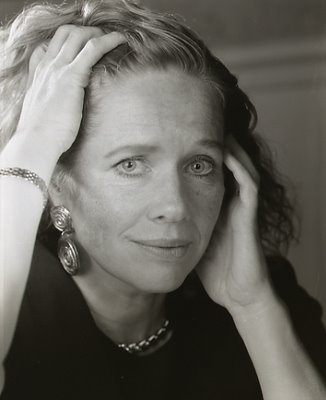
Sometime in mid June 1990 writer John Lekich was assigned by the Georgia Straight to interview Liv Ullmann who was in Vancouver as a UNICEF ambassador. I tagged along as the photographer. The setup was a nightmare as the journalists and photographers were herded into a fairly large and ornate conference room at the Hotel Vancouver. On one end of the room there was a Louis the 15th table. Liv Ullmann was sitting behind. We were told to sit on a row of chairs on the opposite end of the room. Journalists, when their turn came up, were told to stand up and ask their questions. Some asked embarrassing questions. Ms Ullman graciously answered them without putting them on the spot. When John Lekich's turn came, he did the unexpected thing. He went up to Ullmann's table and he moved a nearby chair. He sat down and whispered the questions. In a roomful of journalists, John got his private interview. Taking his cue, as soon as he finished, I moved my lights and camera to the desk. Ms Ullmann looked at me and said, "Don't ask me to smile."
Few know that Liv Ullmann was born in Tokyo and that she is Norwegian by nationality. Her only Swedish connection is her work with Swedish director Ingmar Bergman.
Liv Ullmann
Linn Ullmann
Lolita and the Manila Mango
Friday, March 17, 2006

Maria de los Dolores Reyes de Irureta Goyena, my grandmother, (here in Madrid in 1913 when she was 22), lived in Manila where she spoke Tagalog and English, because the Americans had occupied the Phillipines after the Spanish American War. Indeed, one of my grandfather Tirso de Irureta Goyena's uncles was one of the Spanish generals who surrendered to Admiral George Dewey in 1898 in the Battle of Manila Bay. My grandmother lived with us until I was 21 and she taught me many things besides a love for the Spanish language. She often told me that Tirso was one of the few, if the only, Filipino member of the Real Academia Española which is the final authority of the Spanish language. Lolita taught me to appreciate the arts, specially music. We both loved sweets and she showed me three ways of eating a Manila mango. In the 1500s the Manila Galleons sailed to Acapulco in Colonial Mexico. Two chinese farmers brought with them pits of Manila mangoes and they planted them all (except for a few) in Acapulco where they did poorly. They travelled by land to Veracruz where they planted the remnants. To this day the best Manila mangoes in Mexico grow in Veracruz. My granddaughter Rebecca loves mangoes and insists on eating them with Lolita's favourite method. The mango is sliced lengthwise with a sharp knife on both sides of the pit. These are scooped with a spoon. The pit is then carefully put on a plate and, with a firm hit of the the palm, a table knife is punched in. Here it is, right before Rebecca went after it with gusto.

Mangoes
Real Academia Española
Don Tirso de Irureta Goyena
The Dexterous Sam Sullivan
Thursday, March 16, 2006
 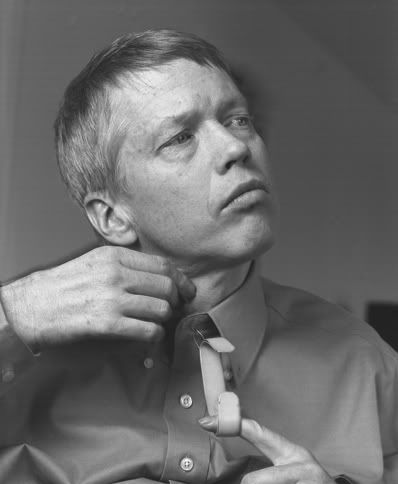 Dexterity: 1527, from M.Fr. dexterite, from L. dexteritatem (nom. dexteritas), from dexter "skillful," also "right (hand)," from PIE base *dek-, cf. Gk. dexios "on the right hand," also "fortunate, clever;" Goth. taihswa; Skt. daksinah "on the right hand, southern, skillful;" Lith. desinas; O.Ir. dess "on the right hand, southern." Klein says the PIE base meant "to take, receive," also "acceptable, becoming, good." The Gk. and L. forms are with the comp. suffix -ter, thus meaning etymologically "the better direction." M.E. dester meant "right hand," and in heraldry dexter means "on the right side." My camera and I spent two days following Vancouver Mayor Sam Sullivan( above with Lynn Zanatta)at home and at work. When I asked him to pose for me, invariably, my idea involved manual dexterity that I have taken for granted for too long. I soon realized that there are two important definitions of dexterity. The one that Sam Sullivan has in spades is the mental kind. But he is more manually dexterous than people suspect. He wraps his arms behind his wheelchair and pulls. This action causes spasms which give him temporary, but limited, use of his hands and wrists. I watched, with amazement, how he buttoned his shirt with a special device designed for his limited hand movement. For two days I watched Sam Sullivan listen to people. After two days, mentally taking his place, I wanted to be alone and not listen to anybody. It was a relief to go home and do that. Even if Sam Sullivan can find some silence he can never leave that wheel chair behind. It is far more implacable than my own shadow.
Frank Dorsey 1927-2006
Wednesday, March 15, 2006
 Imagine listening in to a conversation between two men. One says to the other, "Mine is smaller than yours." Indeed this would be a normal comment if the men were alpine gardeners (also called rock gardeners). But the consumate Vancouver alpine gardener Frank Dorsey , big and tall, with a voice much like Sean Connery's was much too polite to ever boast about his perfect and very small dwarf conifers and alpine plants. At Alpine Garden Club of BC meetings and shows he always went home with the most ribbons. He was a Friend of the Garden (FOG) at UBC for 16 years. Anybody who ever went to the yearly Mother's Day plant sale at the UBC Botanical Garden to line up at 7 am will remember Frank and his voice. With raffle tickets in hand he would loudly flog the delights of Meconopsis betonicifolia (the Himalayan blue poppy) and Cardiocrinum giganteum. But Frank's plants weren't always small. As a 20th century version of the 19th century British amateur gardener he loved and promoted all plants. I have a still small Rhododendron cinnabarinum that I bought from Frank. With its rich cinammon colored indumentum this is one of the most beautiful rhodondendrons. But more beautiful still was the way Frank pronounced that. Alas, he died Monday morning and I will never hear that voice again. I will miss him. Above you can see Frank in his garden holding a treasured selection of Rhodohypoxsis baurii a little bulb plant from South Africa. Alpine Garden Club of BC
Rhododendron racemosum
  By the first week of March my 5 ft tall Rhododendron racemosum is in bud and by the 14 it is in full bloom. You can see above a raceme that I scanned yesterday. This little guy (the leaves are no larger than 4 cm) is from Yunnan, Sichuan and Guizhou provinces in China. French missionary Père Delavay introduced it to the West in 1889. Rhododendron racemosum is a lepidote (scales on the underside of its leaves) from the Subsection Scabrifolia. In Vancouver there are still too many bright or lurid colour hybrids that were in fashion 40 years ago and few realize that there are fragrant rhododendrons ( Rhododendron loderi 'King George' smells like a ripe watermelon) , rhododendrons that can grow in Yellowknife or that azaleas have been promoted and are now classified as rhodos. For me the most interesting feature of a rhododendron is its leaf. There are leaves that can be over a foot long ( R.falconeri) and there are leaves no bigger than the nail of the little finger. In cold weather the leaves of some rhododendrons retract downwards like an angry cat. For years I never noticed a feature of my racemosum which many rhodos have. This is the indumentum (the coating on the back of a leaf). The indumentum can be bright red, brown, white, metalic blue and the texture can be like fine white sandpaper (as in my racemosum) or it can be as smooth as the inside of a cat's ear. When my wife Rosemary and our granddaughter Rebecca walk in VanDusen or at the UBC Botanical Garden, which is supposed to have one of the largest rhododendron collection in North America, we like to inspect the underside of the rhododendrons. Rebecca is always delightfully surprised. UBC Rhodosindumentum
Get Modern or get.......
Monday, March 13, 2006
 Until I came to Canada in 1975 I had no real knowledge of rock and roll. In Mexico my high school students had asked me if I had ever heard of Alice Cooper. My answer of, "No, who is she?" didn't help improve my rating as an uncool teacher. So I tried to like some of the stuff. My favourite was the Allman Brothers Band Live At The Fillmore West. Through working with Les Wiseman at Vancouver Magazine from the late 70s on I began to get my education. Les wrote a column on rock music called In One Ear. He called me Lenso the Argentine Lensman and would talk to me beginning with the expression, "As your attorney ...." I had no idea who Hunter S. Thompson was. I remember the day Les told me, "We critics are really not supposed to like heavy metal. So as your attorney I suggest you listen to Motorhead. I like Motorhead."

One day in the 80s Les called me and told me we had to do something important. So we drove all the way to Boston Bar and back listening to Lou Reed. By May 1982 when I photographed the Cramps(above,left) backstage at the Commodore I was well on my way to becoming a rock snob. One of the best pieces Les ever wrote was on them. I remember going backstage with Les for the interview. A very large tray was passed that had strawberries and pineapple slices on the edges. In the middle was the largest mound of what look like an overturned sugar bowl I have seen outside of the movies. But it was Buck Cherry and Mary-Jo Kopechne's Modernettes that left a lasting influence for me. This circa 1980-83 Vancouver punk band had a motto that they painted sometime in 1979 on the back door of the Smilin' Buddha. It has been my inspiration in helping me stay competitive in this digital revolution. Here you can see the motto behind that other seminal Vancouver punk band, the Dishrags. From left to right it's Jade, Scout, Sue and Kim
Corey Cerovsek, Fritz Kreisler, A Little Girl and a Lemon
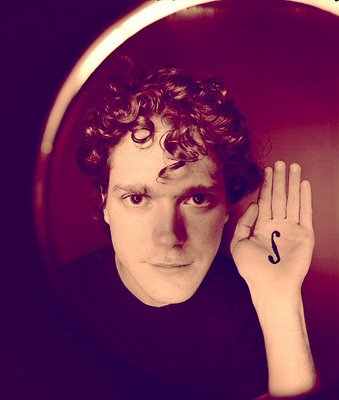
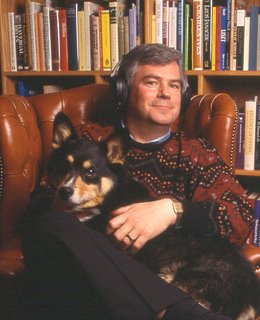

For years Vancouver art connoisseur David Lemon(above,right) has been promoting and backing efforts (with lots of his own money) to make English composers well known. A sure way to make this cheerful man scowl is to ask him, as I once asked him, "Is it true that there are no great English composers after Henry Purcell?" Slowly but surely I have come to appreciate these English composers that Mr Lemon champions. My friend Juan Castelao (Musical Director of the Vancouver Philharmonic Orchestra) told me that Edward Elgar's Violin Concerto in B minor, op 61, was not only difficult (and 45 minutes long) for the soloist but also for the orchestra. So it was with some uncertainty that I took my 8-year-old granddaughter Rebecca(bottom right) to today's performance of the Elgar violin concerto by the Vancouver Symphony Orchestra, directed by Kazuyoshi Akiyama with Corey Cerovsek as the soloist. Rebecca was a bit under the weather and I told her that one uncommon luxury, one should never feel guilty about, is to sleep to good music. She slept through the Allegro, but Corey's passionate performance won out and she was wide awake for the Andante and the Allegro molto. While listening to this complex, but lovely concerto, it ocurred to me that there was a bit of Fritz Kreisler's spirit hovering over the audience at the Orpheum. It was Kreisler who first performed the concerto in 1910. For his score Elgar wrote an inscription borrowed from the Spanish from Alain-Rene LeSage's novel Gil Blas. It reads, "Aqui está encerrada el alma de....." or "Locked here is the soul of....." Before taking photographs of Corey Cerovsek (above left) a third time with the stigmata of an f hole on his hand, Rebecca and I celebrated the pleasant afternoon with tea at the Fairmont Hotel Vancouver.
There will be one more performance of the Elgar violin concerto tonight.
Corey and the VSO
Linton Garner and His Peck Horn
Sunday, March 12, 2006
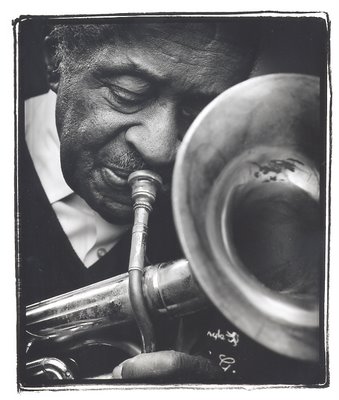 I don't listen to music much anymore when I'm at home. I do go to concerts of baroque and classical music. When I can find some new music concerts I go to those, too. But I don't go to jazz concerts. All of my faves are dead. I have also discovered that just like I have a very good memory for the scent of roses I can listen to music in my head without the CD player. On good days I can remember the voices of some of the jazz players I have met. One in particular is the voice of the gentlemanly J.J. Johnson with whom I had a drink at the Iridium in New York City. Another I remember fondly is the voice of pianist Linton Garner, whose brother Errol was better known. Here you can see Linton when I photographed him in 1997 with his Eb peck horn. My favourite question to ask Linton between sets at Rossini's, where Linton played until he died on March 6, 2003, was: "Linton I understand you are from Pittsburgh. Is there anybody else from there?" His answer was always the same, "There's Roy Elridge, Ahmad Jamal, Art Blakey, George Benson, Kenny Clarke, Stanley and Terry Turrentine, Ray Brown, Billy Strayhorn, Earl Hines, my brother Eroll, Billy Eckstine....." and he would go on and on. So I would interrupt him with, "Who's not from Pittsburgh?" His answer was always the same one, "J.J. Johnson, he's from Indianapolis."
|




















